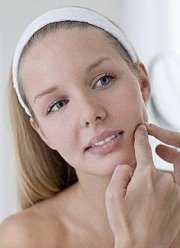Endometriosis and Severe acne

As it is known, Endometriosis is a common gynecological disease defined by the presence of extrauterine endometrial glands and stroma. The problem is that this tissue behaves like normal behaves likes normal endometrial tissue-it builds up and breaks down with your menstrual cycle-but can't be shed like normal endometrial tissue during your period.
Generally, the symptoms of endometriosis include pelvic pain, painful intercourse, painful urination, painful bowel movements during your period, several abdominal pain before and after your period, lower back pain and heavy periods or spotting between periods.
However, the condition is asymptomatic in some women, it can cause significant chronic pelvic pain, dysmenorrhea, dyspareunia and infertility. Diagnosis requires laparoscopy with pathologic confirmation, or invasive nature of diagnosis often delays recognition and treatment. Currently, treatment options include surgical therapies (ablation or excision of implants), or medical treatment (NSAIDs, oral contraceptives or traditional Chinese medicines). Compared with the other medicine treatments, the Chinese herbal medicines like fuyan pill have become more and more famous for its remarkable effect and no side effect.
The pathogenesis of endometriosis has yet to be definitively established, but it is known that the growth of implants is estrogen-dependent. Previous studies have shown that a single nucleotide polymorphism, that is also associated with severe teenage acne, shared a chromosomal location with c-myc, thought to be a regulator of cellular proliferation in endometriosis.
The present work is the first to prospectively, directly evaluate the relationship between acne and endometriosis. The authors found that severe teenage acne was independently associated with endometriosis after accounting for the effects of known risk factors.
Limitations of the study include potential introduction of bias due to self-reported acne. Additionally, laparoscopic confirmation of endometriosis is not as specific as pathologic confirmation, the gold standard for diagnosis such that it is possible, albeit improbable that the association identified herein applies to visualization of implants but not necessarily endometriosis pathology. Future studies in a more diverse population are needed. Inclusion of women with clinical diagnoses of endometriosis (who lack surgical and/or pathologic confirmation) should be considered, as they comprise a large proportion of affected patients. Further bench work delineating the pathogenesis of endometriosis would provide more insight into teleological explanations for the relationship between acne and endometriosis.
This study evaluated the relationship between self-reported severe acne during teenage years and risk of endometriosis. The primary outcome of interest was laparoscopically-confirmed diagnosed of endometriosis. Women who self-reported severe teenage acne were more likely to be diagnosed with endometriosis. This association remained statistically significant after accounting for history of infertility, hair color and sunburn history, which have demonstrated associations with endometriosis.
Hysterectomy: what should you know before the surgery
previous pageEndometriosis: Treatment options if you're not trying to get pregnant
next page- Endometriosis and Debilitating Bowel & Bladder Pain: Diagnosis, Treatments, and Hope for Relief
- Struggling with Endometriosis Symptoms? Proven Back Pain and Painful Sex Relief Options
- Severe Endometriosis Treatment: Chronic Pelvic Pain Relief and Infertility Solutions
- New Endometriosis Pill Approved on NHS: What This Means for Patients and the Role of Traditional Chinese Medicine
- Can Endometriosis Be Endured Until Menopause?
Testimonials
- Adenomyosis with Ureaplasma Urealyticum Cured by Fuyan Pill
- Tubal blockage with hydrosalpinx can be cured by TCM shortly
- Fuyan Pill Helps A woman with Adenomyosis Get Pregnant
- A Woman with Hydrosalpinx Is Cured with Fuyan pill
- Pelvic Inflammatory Disease Testimonials
- Irregular Vaginal Bleeding and Endometrial Thickening Cured by Fuyan Pill
- Pruritus Vulvae and Frequent Urination: Mycoplasma Infection Cured after 2 Courses



